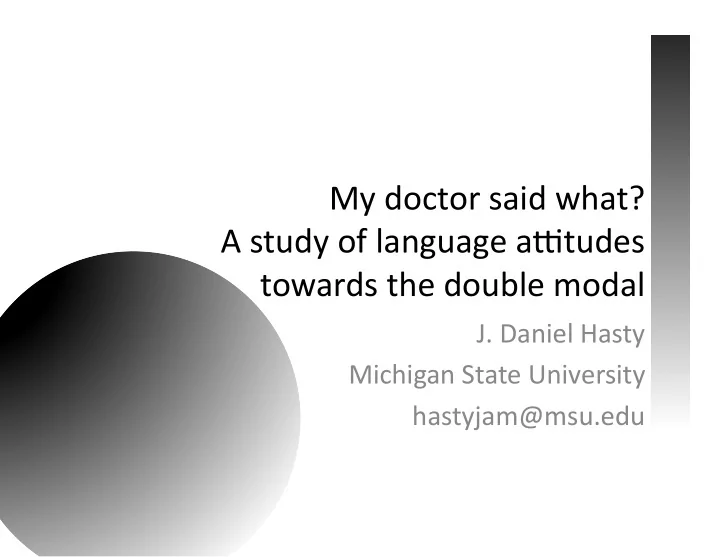

My doctor said what? A study of language a6tudes towards the double modal J. Daniel Hasty Michigan State University hastyjam@msu.edu
Language A6tudes • LiCle known of language a6tudes towards individual linguisEc features – HolisEc approach involving a set of features – Whole languages taken as monolithic • Even fewer studies of morphosyntacEc features – Bender (2005) copula absence in AAE – Campbell‐Kibler (2007) (‐ing) • No previous studies of a6tudes towards the double modal 2
Double Modal • Examples: – You know what might could help that is losing some weight. (Verilogue id:53207) – My bones might not can take that. (Verilogue id: 33896) – We may can just hold it for a while . • PragmaEc condiEoning – Preserving face in the negoEaEon of wants or needs (Mishoe and Montgomery 1994:12) 3
Previous Studies of Double Modals • Focus on the syntacEc structure – Pampel 1975, Coleman 1975, BuCers 1973, BoerEen 1986, Di Paolo 1989, Ba6stella 1995, Hasty in press • Social condiEoning – IndicaEon that DMs used by all social classes • Feagin 1979, Di Paolo 1989 – Used by doctors • 63% of double modals in Verilogue corpus used by doctors (Hasty et al. 2011) • Possible low presEge evaluaEon – Acceptability judgment show Age, EducaEon and Gender condiEoning • With the 20‐30 year olds most likely to accept a dm • Men and the respondents without a college educaEon 4
Research QuesEon • How do community members evaluate someone who uses a double modal? • Hypothesis: – Based on the associaEon of dm acceptance with men and lack of educaEon and its status as a nonstandard feature – Double modal carries a low presEge evaluaEon – Language a6tudes would exhibit a mixture of linguisEc insecurity and covert presEge 5
Methodology • Verilogue Inc. Database – Doctor‐paEent interacEons in over 45,000 office visits across the US • 4 30‐second recordings of doctors using double modals (2 male, 2 female) • Matched Guise Technique (Lambert et al. 1960) – Experimental Guise: double modal ( may can ) – Control guise: digitally removed second modal ( may can to may ) 6
SEmuli • We may can just hold it for a while...(male) • We may can always add…(female) • IsolaEon of the double modal 7
EvaluaEon • Between subjects design – Experimental group (n 20) – Control group (n 20) • Evaluated speaker for 19 paired, polar opposite adjecEves • In response to the frame of evaluaEng the doctor’s bedside manner 8
AdjecEves • Polite—impolite • Intelligent—not intelligent • Confident—not confident • Helpful—not helpful • Genuine—not genuine • Thoughmul—not thoughmul • Educated—uneducated • Above average—below average • Trustworthy—not trustworthy • Good manners—bad manners • Friendly—unfriendly • Humble—not humble • Honest—dishonest • Easy going—not easy going • Responsible—not responsible • Successful—not successful • Comfortable—uncomfortable • Sociable—unsociable • Likable—not likable 9
Speaker QuesEons • State of origin • Urban, suburban, or rural area • Overall impression of the doctor: – Excellent, above average, average, below average, or poor 10
Respondents • Previous studies of Language a6tudes use groups of college students – Accessible, large amount of data – Yields a homogeneous sample • 40 respondents from Northeast Tennessee – Balanced by gender, educaEon, and with a mixture of ages 11
Findings • Overall a significant difference for adjecEves measuring solidarity (p < 0.01) • No difference for Competence adjecEves • No observable social differences among respondents 12
Competence • No observable downgrading of a doctor’s competence based on the use of a double modal • ExplanaEon: – The respondents knew that the speaker was a doctor: • A highly educated and successful profession 13
Factor Analysis • Competence • Friendliness – Educated 0.84 – Friendly 0.91 – Successful 0.63 – Easy.going 0.58 – Responsible 0.59 – Likeable 0.5 – Confident 0.58 • Independent • Socially ACracEve – Polite – Likeable 0.72 – Honest – Comfortable 0.68 – Humble – Genuine 0.58 – Above.average 0.54 – Helpful 0.53 – Confident 0.51 14
Specific Factors 4.6 4.4 4.2 4 Exp Control 3.8 3.6 3.4 Competence Socially Friendliness Polite Honest Humble ACracEve p 0.02 15
Politeness Upgrade esEmate t value Sig (intercept) 3.95 33.09 0.001 experimental group 0.39 2.30 0.02 R‐squared 0.05 p 0.02 16
Discussion • Double modal is associated with politeness – When used by a doctor • Face preservaEon – Confirms analysis of Mishoe and Montgomery (1994) 17
Areas for expansion • Social meaning of double modal in different social situaEons – No negaEve reacEon for doctor but perhaps for other interacEons • No social differences among the respondents – Expand study to include greater numbers of respondents • Single instance of a double modal produce a significant difference in language a6tudes raEngs – Encouragement for studying other low frequency morphosyntacEc features 18
Acknowledgements • Suzanne Evans Wagner, Alan Munn, Gabriela Alfaraz, Carol Myers‐ScoCon, Anne Violin‐ Wigent, Bob Lannon, and Verilogue Inc. • To all my friends, family, and new friends in Tennessee who parEcipated in the study 19
Recommend
More recommend